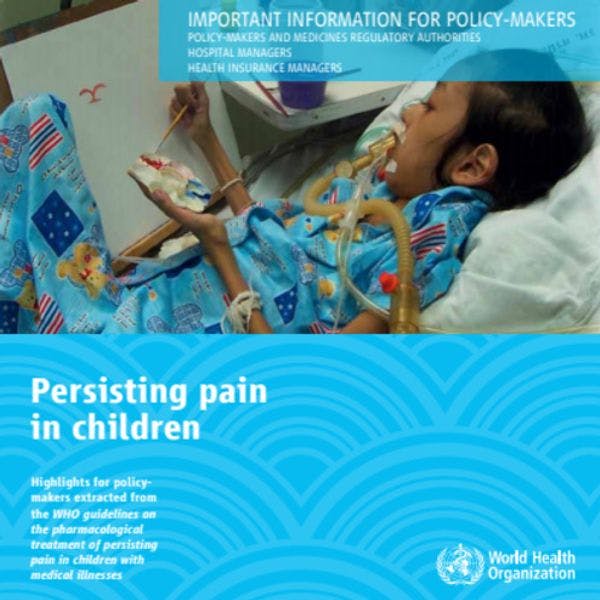Persisting pain in children package: WHO guidelines on the pharmacological treatment of persisting pain in children with medical illnesses
The brochure Persisting pain in children for policy-makers offers concise information which is extracted from the WHO guidelines on the pharmacological treatment of persisting pain in children with medical illnesses unless otherwise stated.
These new WHO guidelines outline basic principles, clinical recommendations and health system recommendations. This brochure highlights selected issues which are essential for, in particular, policy-makers, medicines regulatory authorities, hospital managers and health insurance managers. It will allow them to include in their policies the guidelines’ principle that all patients with pain, including children, should be treated with either pharmacological or non-pharmacological techniques, irrespective of whether the underlying cause can be identified.
The WHO guidelines on the pharmacological treatment of persisting pain in children with medical illnesses address the pharmacological treatment of persisting pain, including cancer pain. As such, it replaces the previous guidelines, Cancer pain and palliative care in children, which exclusively covered cancer pain. The new guidelines on Persisting pain in children are the first of a series of three guidelines documents on all types of pain in both adults and children. The topics of the other two guidelines will be “persisting pain in adults” and “acute pain”.
The World Health Organization (WHO) estimates that around 5.7 billion people live in countries where moderate and severe pain is not adequately treated. Data from the International Narcotics Control Board (INCB) for 2009 show that more than 90 percent of the global consumption of strong opioids occurred in Australia, Canada, New Zealand, the United States of America, the United Kingdom and several other European countries. This means that their availability was very limited in many countries and regions. Over 80% of the world population will have insufficient analgesia.
Medicines for opioid analgesia, such as morphine, are subject to the Single Convention on Narcotic Drugs, 1961, and its 1972 Protocol. As a result, the focus has historically been on prevention of misuse, dependence and diversion while medical access has been neglected. In recent years, growing recognition of the legitimate use of these substances for medical and scientific purposes.
Keep up-to-date with drug policy developments by subscribing to the IDPC Monthly Alert.
Regions
Related Profiles
- World Health Organization (WHO)
